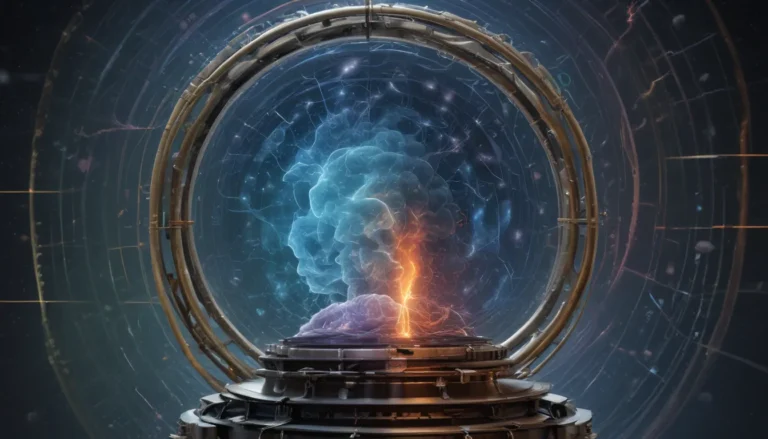A Note About Images: The images used in our articles are for illustration purposes only and may not exactly match the content. They are meant to engage readers, but the text should be relied upon for accurate information.
Welcome to the captivating world of the Weak Nuclear Force! As one of the four fundamental forces in nature, this force may seem enigmatic at first glance, but its effects are far-reaching and crucial to our understanding of the universe. In this article, we will unravel the mysteries behind this fundamental force and explore 11 intriguing facts that shed light on its properties and significance in particle physics and the cosmos.
Understanding the Weak Nuclear Force
The Weak Nuclear Force, also known as the weak interaction, is one of the fundamental forces that govern the interactions between subatomic particles. Unlike its name suggests, this force is anything but weak when it comes to its impact on the physical world. From transforming particles to powering the Sun, the Weak Nuclear Force is a key player in a myriad of processes that shape our universe.
The Role of the Weak Nuclear Force
-
Transforming Particles: The Weak Nuclear Force is responsible for transforming particles into different states through a process called weak decay. This transformation involves the conversion of one type of particle into another, such as a neutron decaying into a proton.
-
Force-Carrying Particles: In the realm of quantum physics, interactions between particles are mediated by force-carrying particles. For the Weak Nuclear Force, these particles are known as W and Z bosons, which facilitate weak interactions between particles.
-
Beta Decay: Beta decay, a type of radioactive decay, is governed by the Weak Nuclear Force. In beta decay, a nucleus emits an electron or a positron, leading to the conversion of one type of quark to another.
Unique Properties of the Weak Nuclear Force
-
Violating Parity Symmetry: The Weak Nuclear Force breaks the principle of parity symmetry, which states that the laws of physics should remain the same when mirrored. This violation of symmetry sets it apart from the other fundamental forces in nature.
-
Short Range: Compared to other fundamental forces like electromagnetism, the Weak Nuclear Force has a relatively short range. It operates within subatomic distances, making it crucial for interactions within atomic nuclei.
Discoveries and Implications
-
Nobel Prize in Physics: The discovery and understanding of the Weak Nuclear Force led to the Nobel Prize in Physics for physicists Carlo Rubbia and Simon van der Meer. Their work provided crucial insights into the nature of this fundamental force.
-
Symmetry Breaking: The Weak Nuclear Force is intimately connected to the concept of symmetry breaking in particle physics. This phenomenon highlights how the laws of physics can appear to differ under different conditions, deepening our understanding of the force.
-
Solar Energy: The Weak Nuclear Force plays a vital role in the nuclear reactions that power the Sun. Through processes like nuclear fusion, this force transforms hydrogen into helium, releasing energy that sustains our star.
Continuing Exploration
Scientists continue to explore the nature of the Weak Nuclear Force, conducting experiments and theoretical research to deepen our understanding of this captivating force. Despite significant progress, there are still mysteries waiting to be uncovered in the realm of particle physics.
Conclusion: Embracing Curiosity
In conclusion, the Weak Nuclear Force is a fascinating and essential component of the universe, shaping our understanding of particle interactions and the stability of matter. From its discovery to its applications in nuclear reactions, this force has revolutionized our understanding of physics and continues to inspire groundbreaking research. Keep that curiosity alive and delve deeper into the forces that govern our existence.
FAQs
-
What is the weak nuclear force?: The weak nuclear force is a fundamental force responsible for radioactive decay and interactions between subatomic particles.
-
How was the weak nuclear force discovered?: Proposed in the 1930s, it was experimentally confirmed in the 1950s through studies of beta decay and neutrino interactions.
-
What role does the weak nuclear force play in the stability of matter?: The force mediates the transformation of elementary particles, contributing to the stability of atomic nuclei.
-
Can the weak nuclear force be harnessed for practical applications?: While primarily manifesting at the subatomic level, its understanding has led to advancements in nuclear physics and medical imaging.
-
Is the weak nuclear force weaker than other fundamental forces?: Yes, it is the weakest of the four fundamental forces, operating at subatomic scales with profound effects.
Embark on a journey of discovery and exploration into the captivating world of the Weak Nuclear Force. As you unravel its mysteries and implications, remember that curiosity and knowledge are the keys to unlocking the secrets of the universe. Stay inspired, stay curious, and keep exploring the forces that shape our reality.






